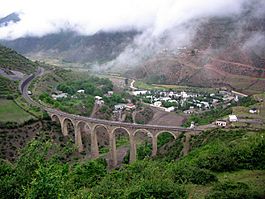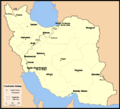Trans-Iranian Railway facts for kids
Quick facts for kids Trans-Iranian Railway |
|
|---|---|

A railway bridge at Do Ab, Mazanderan Province on the Gorgan — Bandar Torkaman line
|
|
| Overview | |
| Native name | راهآهن سراسری ایران |
| Termini | Bandar-e Emam Bandar Torkaman |
| History | |
| Opened | 1938 |
| Last extension | 1963 |
| Completed | 1938 |
| Technical | |
| Track gauge | 1,435 mm (4 ft 8 1⁄2 in) standard gauge |
| UNESCO World Heritage Site | |
| Official name | Trans-Iranian Railway |
| Location | Iran |
| Criteria | Cultural: (ii)(iv) |
| Inscription | 2021 (45th Session) |
The Trans-Iranian Railway (Persian: راهآهن سراسری ایران, romanized: Râh-âhan Sarâsari Irân) is a very important railway line in Iran. It was built between 1927 and 1938. The ruler of Iran at that time, Reza Shah, led the project.
What makes this railway special is that it was built entirely with money from Iran itself. It connects the capital city, Tehran, with the Persian Gulf in the south and the Caspian Sea in the north. Later, the railway was made even longer. In 1961, it reached Gorgan. In 1963, it was extended to connect Tehran with other major cities like Mashhad, Tabriz, and Isfahan.
The original part of the railway, built in 1938, was named a UNESCO World Heritage Site in July 2021. This means it's recognized as very important to the world's history and culture.
Contents
Building Iran's Great Railway
Building the Trans-Iranian Railway was a huge and difficult task. It involved many challenges, from getting money to dealing with tough mountains and deserts.
Early Ideas for a Railway
Before World War I, people had ideas about building a railway to connect the Russian Empire and British India. Russia didn't want this at first. They worried it would hurt their trade in Iran. In 1889, Russia and Iran's Shah (king) even agreed that no railways would be built without Russia's permission.
However, things changed around 1910. Iran's government became more independent. There were also worries about Germany's growing influence in the region. Germany was building the Baghdad Railway, which could connect to Tehran. This made it more important for Iran to build its own railway to protect its trade.
Finding Money for the Project
Finding enough money was a big problem. Russia had spent a lot of money on the Russo-Japanese War in 1905. Britain was also asked for help but couldn't provide funds.
Eventually, a group of Russian banks formed a team called the Trans-Iranian Railway Consortium in 1910. French banks joined in 1911, providing much-needed money. The British were still hesitant to join. They were worried about Russia's plans for India.
Finally, in 1912, Russian, French, and British banks formed a group called "Société d'Etudes" to study the railway project.
Challenges Before World War I
Building the railway faced many delays. The Balkan Wars (1912–1913) made the region unstable. This made investors nervous about putting money into Iran.
Surveys for parts of the railway began in 1914. But progress was slow. Then, World War I started. Russia stopped its plans to build a section of the railway.
After World War I: Modernizing Iran
After World War I, Iran was still a weak country. But Reza Shah Pahlavi started many changes to modernize Iran. Building the Trans-Iranian Railway was a big part of this plan.
Iran's economy grew in the 1930s. New industries appeared, and trade increased. This made the railway project possible.
Some people, including Americans and British, thought the railway was not the best idea. They suggested roads would be cheaper and better for Iran's transportation problems. The railway was also very expensive. It cost Iran a lot of money, which came from taxes on goods like sugar and tea.
How the Railway Was Built
- In 1924, an American company called Ulen started studying a railway line.
- Reza Shah, who became king in 1925, made sure Iran would pay for the railway itself. This was done through taxes on goods like sugar. This way, Iran didn't have to borrow money from other countries.
- In 1927, an international group began building test lines. This group included American and German companies.
- The Americans built a line from Bandar Shahpur to Dezful. The Germans started from Bandar Shah on the Caspian Sea.
- In 1930, the American company left due to payment issues.
- In 1933, Iran hired a Danish company called Kampsax. Kampsax then hired 43 different companies from Europe, the USA, and Iran to do the work.
- Kampsax engineers watched over the work. They finished the project ahead of schedule, and the railway officially opened on August 26, 1938.
The railway is 1,394 kilometers (about 866 miles) long. It has about 230 tunnels and 4,100 bridges! The highest point of the railway is in Arak, which is 2,220 meters (about 7,283 feet) above sea level.
Amazing Engineering Challenges
Building the railway through Iran's mountains and deserts was incredibly hard. Engineers faced many problems:
- They had to abandon some tunnels because of salt or soft ground.
- One tunnel hit a huge empty space inside the mountain. They had to build a bridge inside the tunnel!
- It was hard to find enough fresh water to mix strong concrete.
- Huge bridges, like the Veresk Bridge, were needed to cross deep valleys in the Alborz mountains.
Locomotives: The Trains That Pulled the Loads
When the railway opened in 1938, it used steam locomotives.
- German companies supplied 65 steam locomotives.
- Some were 2-8-0 type (meaning they had 2 small wheels in front, 8 big driving wheels, and 0 wheels at the back).
- Others were 2-10-0 type (2 small wheels, 10 big driving wheels, 0 wheels at the back).
- Iran also used 10 older 0-10-0 locomotives that were used during construction.
World War II: The Persian Corridor
During World War II, the Trans-Iranian Railway became very important.
- In August 1941, British and Soviet forces entered Iran. One main reason was to use the railway.
- The railway was a key part of the "Persian Corridor." This route helped transport oil to Britain and supplies to the Soviet Union.
- The Allies took over the railway's operations in September 1941. British engineers ran the southern part, and Soviet forces ran the northern part.
Boosting Railway Capacity
The British and Soviet forces worked hard to make the railway carry more goods.
- They built new railway yards and a new line to Khorramshahr.
- They brought in many new locomotives and freight wagons.
- When the British first took over the southern part in 1941, the railway could only move one freight train per day.
- By September 1943, they could move 5,400 tons of goods per day! This was a huge increase.
American Help with Trains
In December 1942, the US Army Transportation Corps (USATC) took over the southern part of the railway.
- The railway had many tunnels, which made it hard for steam trains due to smoke. Also, water was scarce in some areas.
- So, the USATC brought in powerful diesel-electric locomotives called ALCO RSD-1s. These were better for the conditions.
- They also brought in many new freight cars.
- By 1944, the railway was moving an average of 6,489 tons of goods per day.
After the war ended in May 1945, the USATC left. The British then returned control of the railway to Iran.
The Railway Today
- In 1961, the railway was extended from Bandar Shah to Gorgan.
- In 2014, a new railway link was completed. It connects Kazakhstan and Turkmenistan with Iran. This new line connects Gorgan to Etrek in Turkmenistan.
- Because the railways in former Soviet countries use a different track width (called Russian gauge), Iran's railway has special services at the border to handle this difference.
The Trans-Iranian Railway remains a vital part of Iran's transportation system and a symbol of its history.
Images for kids
See also
- Transport in Iran
- Islamic Republic of Iran Railways





